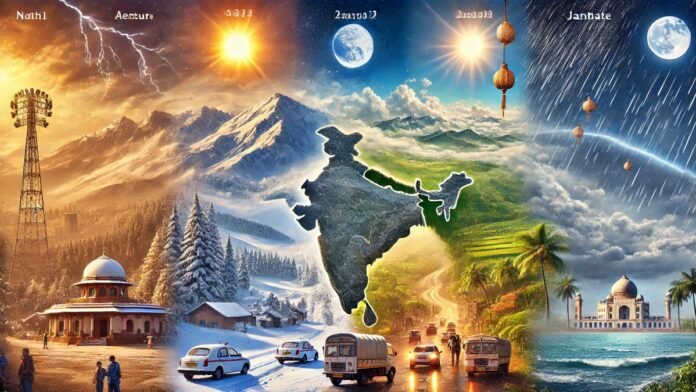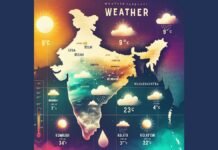
Key Points
- Delhi-NCR experienced a sharp temperature drop on October 28, 2025, with minimum temperatures falling to 17-19°C, the coldest for October since 2020
- Maximum temperatures are expected to hover between 27-28°C, significantly lower than the October average of 31-33°C
- Light rain and drizzle are likely during early morning hours due to an active western disturbance affecting the Himalayan region
- The India Meteorological Department (IMD) has forecast a colder-than-usual winter for North India with temperatures potentially 1-2°C below normal
- La Niña conditions are expected to develop between October and December, contributing to a longer and more intense winter season
- Heavy snowfall has already blanketed higher reaches of Himalayas in Jammu & Kashmir, Himachal Pradesh, and Uttarakhand
- Air quality in Delhi continues to deteriorate, reaching “moderate” to poor levels as temperatures drop
New Delhi: The national capital region woke up to a distinctly chilly morning on Tuesday, October 28, 2025, marking one of the coldest October days in recent years. According to the India Meteorological Department’s Regional Meteorological Centre in New Delhi, the minimum temperature plummeted to 17.3°C at Lodhi Road and 17.9°C at Palam, representing a dramatic shift toward early winter conditions.
The maximum temperature is forecast to reach only 27-28°C today, with generally cloudy skies accompanied by mist and haze during morning hours. The IMD has predicted one or two spells of very light rain or drizzle during the early hours and morning, further intensifying the chill factor. Wind speeds of approximately 4-5 km/h are expected throughout the day, with humidity levels reaching as high as 96% during morning hours.
This October has proven exceptionally cool compared to recent years, with weather scientists observing that Delhi’s maximum temperatures have remained consistently lower than normal while minimum temperatures hover around average levels. The temperature pattern is reminiscent of October 2020, when Delhi experienced its coldest October since 1962, with a mean minimum temperature of 17.2°C.
Western Disturbance Brings Early Winter Signals
The sudden change in weather conditions is attributed to an active western disturbance currently affecting the Himalayan regions. This meteorological phenomenon has brought heavy snowfall to the higher reaches of Jammu and Kashmir, Ladakh, Himachal Pradesh, and Uttarakhand during the second week of October, much earlier than usual.
The effect of this snowfall in the mountains is now cascading down to the plains, bringing cold winds that have caused both maximum and minimum temperatures to drop to record lows for this time of year. The maximum temperatures have dipped to the range of 26-30°C, while minimum temperatures have ranged from 18-19°C for over 10 days, in stark contrast to the average mean maximum temperature of 31-33°C and average mean minimum temperature of 19-22°C typically observed during October.
Weather experts note that the combined effects of the western disturbance and changing atmospheric conditions are setting the stage for a potentially severe winter ahead. Many Delhi residents have already started wearing light warm clothes and reducing fan speeds at night, clear indicators that winter has arrived ahead of schedule.
La Niña to Intensify Winter Cold
Adding to the early winter chill, meteorological agencies have forecast the development of La Niña conditions between October and December 2025. The India Meteorological Department, along with the US Climate Prediction Centre, has indicated a 71% probability that North India, including Delhi and the National Capital Region, will experience a colder-than-usual winter this year.
La Niña typically brings below-normal temperatures to North India, with the IMD predicting that minimum temperatures could be 1-2°C lower than average across the region. This weather pattern is expected to result in greater disparities between day and nighttime temperatures, a more pronounced chill across larger regions of the country, and a longer and more intense season than typical.
Weather Impact Across North Indian States
Uttar Pradesh: Cold Winds and Rain Warning
Uttar Pradesh is experiencing a significant weather shift, with cold winds and sporadic rainfall affecting various parts of the state. Meteorologists have warned that thunderstorms and rain are possible in the western and eastern regions over the next few days, influenced by atmospheric disturbances from both the Arabian Sea and changing weather patterns.
The state’s temperature has been dropping steadily, with mornings and evenings becoming noticeably cooler. Residents across major cities, including Lucknow, Kanpur, and Agra, have reported feeling the chill, particularly during early morning hours when temperatures dip considerably.
Bihar: Chill Sets In, Rainfall Alert Issued
Bihar is currently experiencing mild to moderate cold during mornings and evenings, with mild sunshine maintaining relatively pleasant daytime conditions. However, the Meteorological Department has forecast that temperatures will drop further after the Chhath festival, which marks a traditional transition point toward winter in the region.
A thunderstorm warning has been issued for parts of northern Bihar and Jharkhand from October 28 to November 1, 2025. Due to weather disturbances in the Bay of Bengal region, a heavy rainfall alert remains in effect for Bihar, Jharkhand, Odisha, and West Bengal. Residents have been advised to remain vigilant and take necessary precautions during this period.
Uttarakhand: Dry Weather with Mountain Chill
Uttarakhand is witnessing predominantly dry weather conditions, though mornings and evenings are becoming progressively cooler across the state. Dehradun and the surrounding areas experienced bright sunshine on Monday, providing some warmth during midday hours. However, partly cloudy skies persisted in some mountainous regions, indicating ongoing atmospheric activity.
The Meteorological Department has predicted light rain in some higher reaches of the state over the next 24 hours, particularly in areas above 3,000 meters in elevation. The hill stations have already witnessed early snowfall, with popular tourist destinations like Mussoorie and Nainital reporting temperatures dropping to single digits during night hours.
Heavy snowfall has blanketed the higher altitudes of Himachal Pradesh and Jammu & Kashmir, transforming hill stations like Gulmarg into winter wonderlands much earlier than usual. Snowfall persisted throughout the week in higher-altitude areas of Himachal Pradesh, while rainstorms battered the lower regions of the state, resulting in a discernible decrease in temperature across Punjab and Himachal.
Air Quality Concerns Intensify
As temperatures continue to decline, air pollution levels in Delhi-NCR are gradually increasing, a pattern typically observed during the transition from autumn to winter. The air quality in the national capital has been classified as “moderate” to poor, with the Air Quality Index (AQI) showing concerning levels in several monitoring stations.
New Delhi experienced a sunny and pleasant morning on October 28, 2025, with temperatures around 28.9°C, but residents continued to grapple with air quality concerns. The combination of dropping temperatures, reduced wind speeds, and the onset of the crop residue burning season in neighboring states typically creates conditions conducive to smog formation and pollutant accumulation.
Health experts have advised residents, particularly those with respiratory conditions, to limit outdoor activities during early morning and late evening hours when pollution levels tend to peak. The use of air purifiers indoors and wearing N95 masks outdoors has been recommended for vulnerable populations, including children, elderly persons, and those with pre-existing health conditions.
Week Ahead Weather Forecast
The seven-day weather forecast for Delhi-NCR indicates a gradual warming trend over the coming days, though temperatures will remain below seasonal averages. According to the IMD, maximum temperatures are expected to rise from 27°C on October 28 to approximately 30°C by November 2, before dropping slightly to 28°C on November 3.
Minimum temperatures are likely to fluctuate between 19-21°C during this period, maintaining the early winter chill during morning and evening hours. Clear skies with occasional cloudy intervals are expected after October 28, with no significant rainfall predicted for the next week.
The sun is rising at approximately 6:30 AM and setting around 5:40 PM, with daylight hours continuing to shorten as winter approaches. Moonrise and moonset timings indicate the waning lunar phase, with the moon setting on October 28 at 10:40 PM and rising on October 29 at 1:05 PM.
Expert Predictions for Winter Season
Weather experts emphasize that while early indicators suggest a colder-than-usual winter, it remains too early to confirm the full severity and duration of the 2025-26 winter season with absolute certainty. However, the convergence of multiple factors, including La Niña development, early western disturbances, and heavy Himalayan snowfall, points toward a potentially challenging winter ahead.
Meteorological scientists note that the unusual cold in October suggests one of the coldest winters in decades may be approaching, though they caution that weather patterns can shift dramatically over the coming months. Areas of central India may enjoy drier and crisper air, while the southern peninsula, which usually stays moderate, may experience an unusual drop in minimum temperatures.















































